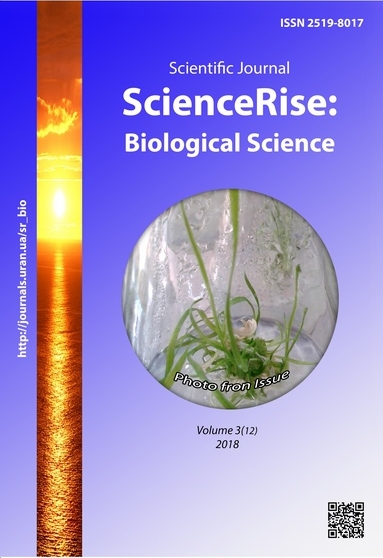Influence of ammonia of waters from the surface sources of water supply on their toxicity for Rana Ridibunda (Pallas, 1771)
DOI:
https://doi.org/10.15587/2519-8025.2018.135657Keywords:
toxicity of waters, ammonia, R. ridibunda, biotesting, non-typical motor activity, «time sampling»methodAbstract
Aim. Revelation of the influence of ammonia from surface water supply sources on formation of their toxicity, determined by indices of motor activity of young lacustrine frogs (Rana ridibunda Pallas, 1771).
Methods. Biotesting was conducted by the method of «time sampling» with preliminary exposure of individuals for 12 hours (n=30) in test samples of water, taken from the Denishevsky water storage basin and Otsechne water intake of the river Teterev and also in samples of settled water from water pipe as a control. The indices of water toxicity were calculated by reactions of typical and non-typical activity of individuals. The ammonia content was determined by the photometric method with Nessler reagent. The correlation and regression analysis was realized by the standard computer program MO Excel 2003.
Results. There are established the effects of the ammonia influence on the toxicity of test waters that is proved by the values of determination coefficients, received for 3-year period (R2 at level 0,3893 for the water storage basin and 0,2814 for water intake) and correlation (r of middle degree 0,6240 and 0,5305 respectively). There are constructed the graphs, expressed by the equations of rectilinear regression (y=52,535x+16,207 and y=50,917x+21,067), that gives a possibility to prognosticate toxicity levels of waters as to the ammonia content for the water storage basin and water intake.
Conclusions. There were revealed the correlations of the indices of toxicity of the testing waters with the ammonia content that in 2014 (0,6939 – in the Denishevsky water storage basin and 0,6803 – in the Otsechne water intake) reached more degree than in 2012 (0,6413 and 0,4281) and 2013 (0,6556 and 0,5083) years, respectively that is conditioned by increasing ammonification processes. There was fixed a tendency of increasing the force of the ammonia influence (from 41,12 to 48,15 % in waters of the water storage basin and from 18,33 to 46,28 % – water intake) on the toxicity of these waters. In the 3-years period of the studies, there was testified the presence of the reliable ammonia influence of the toxicity of waters in the water storage basin at level 38,93 % (F=3,0811; p ≤0,05, ), and also its absence in the water intake 28,14 % (F=1,5663). There were given the equations of rectilinear regression and graphic images of the dependencies that allow to calculate the ammonia content (0,58 mg/dm3 and 0,64) at reaching 50 % level of water toxicity of lacustrine frogs
References
- Zapolskyi, А. K., Shumigay, I. V. (2015). Okhorona vod vid vysnazhennia i sabrudnennia. Аgroecologichnyi zhurnal, 3, 6–15.
- Malik, A., Grohmann, E., Akhtar, R. (Eds.) (2014). Environmental Deterioration and Human Health: Natural and anthropogenic determinants. Dordrecht; Heidelberg; London; New York: Springer, 8–16. doi: http://doi.org/10.1007/978-94-007-7890-0
- Hriuk, I., Sukhodolska, I. (2012). Vmist spoluk nitrogenu e void malykh richok. Visnyk L'vivs'koho universitetu. Seriia biologichna, 60, 227–238.
- SanPiN 4630-88. (1988). Sanitarnyie pravila i normy okhrany poverkhnostnykh vod ot sagriasnenia, Moscow: Min. Sdravookhran SSSR, 70.
- Dudnik, S. V. (2014). Vodna toksykolohiia. Part 2: Ichtiotoksykolohiia. Kyiv, 108.
- Arystarkhova, Е. О. (2017) Otsiniuvannia toksychnisti sabrudnenykh amoniakom vod Сarassius auratus gibelio (Вloch, 1782) metodom «time sampling». Rybohospodars'ka nauka Ukrainy, 4, 33–41.
- Schneeweiss, N., Schneeweiss, U. (1997). Amphibienverluste infolge mineralischer Dȕngung auf Agrarflächen. Salamandra, 33 (1), 1–8.
- Schneeweiss, N., Schneeweiss, U. (1999). Gefährdung von Amphibien durch mineralische Dȕngung. Rana, 3, 59–66.
- Melikhova, О. P., Egorova, Е. I. (2007). Biologicheskii kontrol' okruzhaiushchei sredy: bioindycatsia i biotestuvannia. Moscow: Isd. zentr «Akademia», 288.
- ASTM, Standard Guide for Conducting Acute Toxicity Tests on Aqueous Ambient Samples and Effluents with Fishes, Macroinvertebrates, and Amphibian (2008). ASTM International. URL: https://www.astm.org/DATABASE.CART/HISTORICAL/E1192-97R08.htm
- Lur'ie, U. U. (Ed.) (1973). Unifizyrovannyie metody analisa vod. Moscow: Isdatiel'stvo Chimia, 376.
- Biliavskiy, H. О., Butchenko, L. І. (2006). Osnovy ekolohii: teoria ta praktykum. Kyiv: Libra, 368.
Downloads
Published
How to Cite
Issue
Section
License
Copyright (c) 2018 Еlla Аrystarkhova, Ludmila Romantschuk, Yevgen Dankevych, Olena Zhytova

This work is licensed under a Creative Commons Attribution 4.0 International License.
Our journal abides by the Creative Commons CC BY copyright rights and permissions for open access journals.
Authors, who are published in this journal, agree to the following conditions:
1. The authors reserve the right to authorship of the work and pass the first publication right of this work to the journal under the terms of a Creative Commons CC BY, which allows others to freely distribute the published research with the obligatory reference to the authors of the original work and the first publication of the work in this journal.
2. The authors have the right to conclude separate supplement agreements that relate to non-exclusive work distribution in the form in which it has been published by the journal (for example, to upload the work to the online storage of the journal or publish it as part of a monograph), provided that the reference to the first publication of the work in this journal is included.









